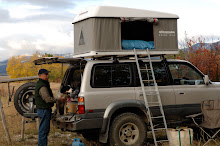
Fitment of roof tents and vehicle top load limits demystified
Supporting the tent platform
A well made tent has a rigid bottom platform that distributes weight to the rack system and does not require propping up with multiple load bars. Theoretically, it can be functionally mounted on a single pair of proper cross bars. Adding a full rack system that weighs 100 to 200 lbs. is a BAD idea, because dynamic roof load limits (see below) are finite, and should not be violated. If your rack and basket combination weighs 150 lbs. and the tent and gear weighs 130 lbs., the total load is 280 lbs, which exceeds the dynamic roof loading limit of almost all vehicles in the US. The Hummer H1, I think, is rated for this type of load. A Landcruiser or similar vehicle is not.
Specified dynamic roof loading limits
Load limits specified by vehicle and roof rack manufacturers deal with allowable limits while the vehicle is moving. In no case does the use of any rack allow carriage of weights in excess of the vehicle manufacturer's recommended load limit. The issue is NOT the absolute strength of the roof - modern vehicles are engineered to sustain roll-over loads. The limits are imposed by the braking and handling characteristics of the vehicle, as well as the absolute total vehicle load specifications. I tell people to imaging driving into a downhill curve at 50 MPH in a snow storm, and a deer jumps into the highway. How will the vehicle handle in an emergency? If under the rated laod limit, it should do fine. With 300 or more pounds on the roof - not so fine. Load limits may vary by country, but we, and vehicle manufacturers, tend to be conservative. You should be too.
It should be noted that pick-up truck are rated for laods in the beds that are far higher than SUV roof loads. A truck with a 130 lb. tent on a bed mounted rack system or camper shell, with a load of 500 lbs. in the bed would present no problems in a standard half ton pick-up truck.
Absolute load limits
As far as we know, no vehicle or rack system manufacturer has published static load limit specifications. In nearly one thousand tents over the years we have never found that the static loads of the tent and occupants is a problem.
Distribution of load weight
The distribution (transfer of weight from the tent to the vehicle is dependent upon how the load bars are configured. If the factory side rails or tracks are used, they will distribute the weight of the tent fairly evenly across the roof. However, the factory cross bars provided with the standard factory rack are not suitable for any serious loads. Many are mainly cosmetic - made of hollow aluminum covered with vinyl or painted. Many are curve to form a bow shape. The side rails or tracks are quite strong and should be used to support an aftermarket rack system - Thule and Yakima are what we usually recommend. The tent mounts to the aftermarket load bars. This is a proven combination that has been used by many hundreds of our customers.
If a gutter mount roof rack system is fitted for mounting the tent, the weight of the tent and occupants are supported by the vehicle gutters. In this case we recommend the use of three or more cross bars when travel over rough surfaces is expected. The feet of the gutter mount towers also have to be set up properly to keep the pounding from rough roads from cracking the waterproof caulking in the gutters - which will lead to leaks and eventual rust in the roof pillars. We recommend that the lower edge of the gutter foot be fitted with a piece of split silicone tubing to act as a cushion between the gutter foot and the bottom of the gutter. In addition, when the tower is mounted, pull the foot to the outside edge of the gutter before tightening the clamp completely.
Distance between front and rear load bars
All of our hard shell tents - Maggiolina and Columbus models - have minimum and maximum limits for the distance between the front and rear load bars. The maximum distance is 54" - the minimum distance is 30" - and we find about 48" is about optimal.


